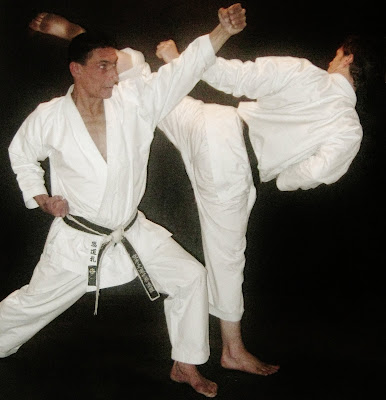



On Sunday and Monday I taught four traditional Shotokan karate clinics in Palmerston North. The first two were group seminars whilst the others were private sessions (for USKU New Zealand Chief Instructor Morgan Dilks Sensei, who kindly hosted me).
_________
KIHON: The overall theme of both open and private classes focused on maximisation of koshi no kaiten (the rotation of the hips), tai no shinshuku (the compression and stretch of the body) and junansei (softness/relaxation) to generate effective power for actual self-defence... REAL KARATE! I noticed that many people were surprised how their physical power changed from this; and a wide gulf between sports/game karate, and authentic traditional/martial arts karate was decisively established.
_________
Due to the wide range of grades present on Sunday I taught an ample amount of “kihon” to provide a comprehensive introduction of Asai Tetsuhiko Shuseki-Shihan’s approach to Shotokan. Morgan Sensei made this very easy, as he understands Asai-ryu Karate from previous instructor training, and has lived, and trained extensively in Japan, directly under Fukamizu Kennichi Shihan in Miyazaki-ken.
_________
KOTEN-KATA: To bolster what was practiced in kihon I typically utilised an Asai-ryuha Koten-Kata as a tabula rasa. Keeping this in mind, rather than following the orthodox format (of teaching the accompanying bunkai/oyo-jutsu) we concentrated on the fundamental generation of power, as dictated by the seminars technical objectives established in the kihon-geiko. This was also applied to the opening movements of Heian-shodan kata.
_________
KUMITE: Amongst other things we worked on the correct distance and trajectories for various keriwaza (kicking techniques) namely penetration of the target for optimal effect. This maai training also involved Asai Sensei’s introductory ducking techniques which are intrinsically connected to irimi. Naturally all techniques practiced linked back to the criticality of koshi no kaiten, tai no shinshuku and junansei/muchiken.
 PRIVATE TRAINING:
PRIVATE TRAINING: The private lessons I gave Morgan Sensei on Monday covered more refined/advanced skills, kata and bunkai/oyo-jutsu. These skills are for him to keep and teach to his members, at his own discretion, so I will not go into details here.
I’d once again like to thank Morgan & Yuko for hosting us, and everyone who we had the pleasure of meeting whilst in Palmerston North. Osu!
© André Bertel. New Zealand, 2010.
 I've uploaded a video of SEIRYU KATA on Youtube. This Asai-ha Shotokan-ryu Karatedo Koten Kata focuses primarily on muchiken-waza (whip fist techniques).
I've uploaded a video of SEIRYU KATA on Youtube. This Asai-ha Shotokan-ryu Karatedo Koten Kata focuses primarily on muchiken-waza (whip fist techniques).  ody into a whip.
ody into a whip. ube: http://www.youtube.com/watch?v=uNcOeu5Fv20
ube: http://www.youtube.com/watch?v=uNcOeu5Fv20






































